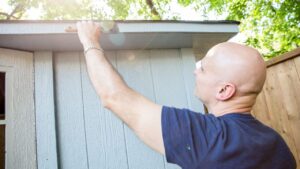Unlocking the thrill of a fresh new look for your room often starts with the somewhat tedious task of removing the old wallpaper. While it might seem like a daunting chore, don’t worry! We’re here to guide you through it. With a little patience and the right approach, you’ll find that getting rid of that dated design can be quite manageable.
Assessing The Type Of Wallpaper
Before you begin, it’s important to identify the kind of wallpaper you’re dealing with. Knowing what you’re up against can significantly streamline the removal process and help prevent unnecessary damage to your walls.
Generally, wallpaper falls into three categories: peelable, washable, and traditional. Peelable wallpaper has a top layer that can be easily pulled off, leaving a paper backing that still needs to be removed. Washable wallpaper, on the other hand, is designed with a plastic coating that resists water, making it a bit trickier to remove as it requires additional steps to allow solvents to penetrate. Traditional wallpaper, usually made of paper and glued directly to the wall, can also present its own set of challenges. Remember, each type requires a different removal strategy, so accurate identification is key!
Essential Tools & Materials For Wallpaper Removal
Now that you’ve identified the type of wallpaper you’re dealing with, it’s time to gather the necessary tools and materials. Having everything at hand before you start will make the process go smoothly.
To start, you’ll need a scoring tool. This handy gadget is used to create tiny holes in the wallpaper, allowing your removal solution to penetrate through the paper and reach the adhesive. A plastic scraper or putty knife is another essential tool for gently peeling off the wallpaper once the adhesive has been loosened.
For applying your removal solution, you’ll need a sponge or soft cloth, and a spray bottle or bucket. The solution itself can be a mix of warm water with either dish detergent, fabric softener, or vinegar. Each has its own benefits, but all are effective at breaking down wallpaper adhesive.
In some cases, particularly with stubborn wallpapers, you might need a wallpaper steamer. This tool uses steam to soften the adhesive, making it easier to scrape off the paper. It’s not always necessary, but it can be a real game-changer for those tough-to-remove wallpapers.
So, with the appropriate assessment and the right tools in hand, you’re well-prepared to tackle your wallpaper removal project. In the next sections, we’ll guide you through the step-by-step process for each type of wallpaper.
Step-by-Step Guide For Removing Peelable Wallpaper
Let’s start with the easiest type of wallpaper to remove – peelable wallpaper. This type of wallpaper is designed with a top layer that can be peeled off, revealing a backing that still needs to be dealt with. Here’s how to do it:
First, pick at a corner or edge with your thumbnail or a plastic scraper until it lifts from the wall. Once you’ve got a grip on it, start peeling. The top layer should come away easily. However, don’t be surprised if some areas need a little coaxing. Just be patient and work slowly to avoid tearing the paper or damaging the wall underneath.
With the top layer removed, you’ll be left with the paper backing. This can’t be peeled off in the same way, but don’t worry, we’ll cover how to remove this in the next section.
Techniques For Removing Washable or Stubborn Wallpaper
Washable wallpaper, as well as stubborn traditional wallpaper, requires a bit more effort to remove. The waterproof layer and hardened adhesive can make this a challenging task, but with the right technique, it’s entirely doable.
Start by scoring the wallpaper with your tool, creating tiny punctures that will allow your removal solution to penetrate. You’ll want to be gentle with this process to avoid damaging the wall underneath.
Next, mix your removal solution. Warm water and dish detergent, fabric softener, or vinegar all work well. Apply this solution to the wallpaper using a sponge or spray bottle and let it soak in for about 15-20 minutes. This will soften the wallpaper and the adhesive, making it easier to scrape off.
Once the paper is sufficiently soaked, begin scraping it off with your plastic scraper or putty knife. Work in small sections, and reapply your solution as necessary. Be gentle during this process to avoid damaging the wall.
Using a Wallpaper Steamer for Extremely Stubborn Wallpaper
Some wallpapers, particularly older, more stubborn ones, may resist your removal efforts. When this happens, it’s time to bring out the big guns – a wallpaper steamer.
This tool uses steam to soften the adhesive, making it easier to scrape off the paper. To use it, fill the steamer with water and let it heat up. Then, press the steamer pad against the wall for about 10 seconds at a time. Immediately after, scrape off the loosened paper with your scraper.
Remember, the key to successful wallpaper removal is patience and gentleness. You don’t want to rush the process and risk damaging your walls. Take your time, and before you know it, you’ll have a fresh, clean wall ready for a new look.
Cleaning & Preparing Walls After Wallpaper Removal
Congratulations! You’ve successfully removed the wallpaper. But your task doesn’t end here. Now comes the crucial step of cleaning and preparing the walls for a fresh coat of paint or new wallpaper.
Begin by inspecting the wall for any residual adhesive. Often, remnants of glue or paste are left behind, these can interfere with your new paint job or wallpaper application. To remove this, prepare a simple cleaning solution. Mix warm water and a few drops of dish soap in a bucket.
Next, using a soft cloth or sponge, gently scrub the walls with the cleaning solution. This will help to remove the remaining adhesive and any small pieces of wallpaper that may still be clinging to the wall. It’s important to scrub gently to avoid causing any damage to the wall surface.
In some cases, particularly if the wall had been wallpapered for many years, you might find heavy paste residue. This requires a more intensive cleaning method. Commercial wallpaper stripper can be used in such scenarios. After applying the stripper, rinse the wall with a sponge and hot water to ensure all the residue is completely washed off.
Finally, dry the wall thoroughly with a clean cloth or rag. It’s important to let the wall dry completely before proceeding with any new paint or wallpaper. This can take anywhere from a few hours to a full day, depending on the room’s conditions and the wall’s material.
Tips For Avoiding Damage During Wallpaper Removal
Removing wallpaper is a delicate process, and if not done properly, it can lead to unnecessary wall damage. Here are a few tips to help you avoid this.
Firstly, be patient. Rushing through the process can lead to tears in the wall’s surface. Work slowly, and allow the removal solution or steam to do its job of loosening the adhesive.
Secondly, use the right tools. A plastic scraper or putty knife is ideal because it’s gentle on the walls. Metal tools can easily gouge the wall, leaving unsightly marks.
Lastly, be mindful of the amount of water you’re using. Over-saturation can seep into the wall and cause damage. Always start with a small amount of water, and gradually increase if needed.
Common Challenges & Solutions in Wallpaper Removal
Even with the best preparation and care, you might encounter some issues during the wallpaper removal process. Let’s address a few common challenges and their solutions.
If the wallpaper is not coming off easily, it’s likely that it hasn’t been sufficiently soaked. In such a case, reapply your solution and wait a little longer before attempting to scrape again.
When dealing with multiple layers of wallpaper, you’ll need to repeat the removal process for each layer. It can be a time-consuming process, but it’s necessary for a clean, smooth surface.
Finally, if you’re struggling with stubborn, old wallpaper that refuses to budge, consider renting or purchasing a wallpaper steamer. The steam will soften the adhesive and make the removal process much easier.
Despite these challenges, with patience and the right techniques, you can effectively remove your old wallpaper and prepare your wall for a fresh, new look.






